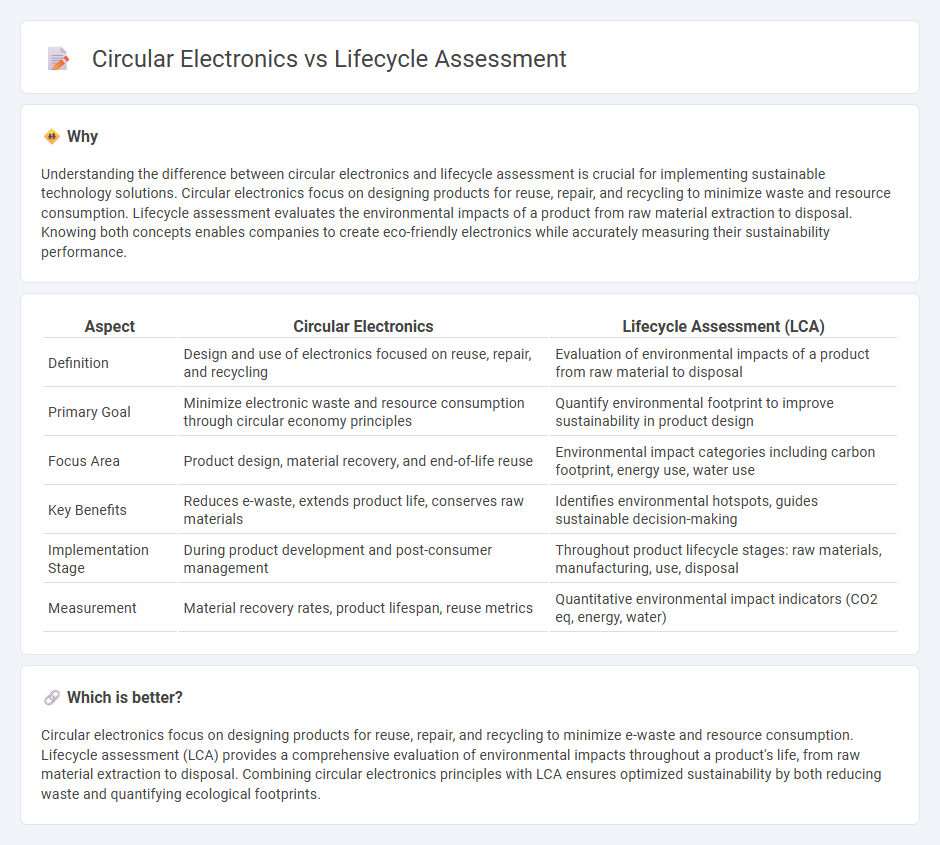
Circular electronics prioritize sustainable design by maximizing reuse, repair, and recycling to reduce electronic waste and environmental impact. Lifecycle assessment (LCA) evaluates the environmental footprint of electronic products throughout their entire lifecycle, from raw material extraction to disposal. Explore how integrating circular electronics principles with lifecycle assessment can drive innovation in sustainable technology development.
Why it is important
Understanding the difference between circular electronics and lifecycle assessment is crucial for implementing sustainable technology solutions. Circular electronics focus on designing products for reuse, repair, and recycling to minimize waste and resource consumption. Lifecycle assessment evaluates the environmental impacts of a product from raw material extraction to disposal. Knowing both concepts enables companies to create eco-friendly electronics while accurately measuring their sustainability performance.
Comparison Table
| Aspect | Circular Electronics | Lifecycle Assessment (LCA) |
|---|---|---|
| Definition | Design and use of electronics focused on reuse, repair, and recycling | Evaluation of environmental impacts of a product from raw material to disposal |
| Primary Goal | Minimize electronic waste and resource consumption through circular economy principles | Quantify environmental footprint to improve sustainability in product design |
| Focus Area | Product design, material recovery, and end-of-life reuse | Environmental impact categories including carbon footprint, energy use, water use |
| Key Benefits | Reduces e-waste, extends product life, conserves raw materials | Identifies environmental hotspots, guides sustainable decision-making |
| Implementation Stage | During product development and post-consumer management | Throughout product lifecycle stages: raw materials, manufacturing, use, disposal |
| Measurement | Material recovery rates, product lifespan, reuse metrics | Quantitative environmental impact indicators (CO2 eq, energy, water) |
Which is better?
Circular electronics focus on designing products for reuse, repair, and recycling to minimize e-waste and resource consumption. Lifecycle assessment (LCA) provides a comprehensive evaluation of environmental impacts throughout a product's life, from raw material extraction to disposal. Combining circular electronics principles with LCA ensures optimized sustainability by both reducing waste and quantifying ecological footprints.
Connection
Circular electronics focus on designing devices for easy repair, reuse, and recycling to reduce electronic waste. Lifecycle assessment evaluates the environmental impacts of electronics from raw material extraction through manufacture, use, and end-of-life. Integrating lifecycle assessment in circular electronics initiatives helps optimize resource efficiency and minimize ecological footprints across the entire product lifecycle.
Key Terms
Environmental Impact
Lifecycle assessment (LCA) quantifies the environmental impact of electronic products by evaluating resource extraction, manufacturing, use, and disposal stages to identify hotspots of carbon footprint and waste generation. Circular electronics emphasize designing products for longevity, reuse, repair, and recycling to minimize raw material consumption and electronic waste throughout their lifecycle. Explore how integrating LCA with circular electronics strategies can significantly reduce environmental harm in the tech industry.
Resource Recovery
Lifecycle assessment quantifies environmental impacts of electronics from production to disposal, emphasizing energy use and material flow. Circular electronics prioritize resource recovery by designing products for durability, reuse, and recycling to minimize waste and conserve critical materials like rare earth metals. Explore deeper insights into how these approaches drive sustainable electronics innovation and resource efficiency.
Product Design
Lifecycle assessment (LCA) evaluates the environmental impacts of electronic products from raw material extraction to disposal, guiding sustainable product design by identifying hotspots in energy use, emissions, and waste generation. Circular electronics emphasize designing products for reuse, repairability, and recyclability, extending product lifespan and minimizing e-waste through modular components and eco-friendly materials. Explore the latest strategies combining LCA insights with circular design to revolutionize sustainable electronics.
Source and External Links
Life Cycle Assessment (LCA) - Everything you need to know - An LCA measures the environmental impact of a product through every phase of its life, from production to waste or recycling, and consists of four phases defined by ISO standards: Goal and Scope Definition, Inventory Analysis, Impact Assessment, and Interpretation.
Life-cycle assessment - Wikipedia - Life cycle assessment (LCA) is a methodology for assessing environmental impacts associated with all stages of a product's life cycle, from raw material extraction through manufacture, use, and disposal, following ISO 14040 and ISO 14044 standards.
Life Cycle Assessment - PwC - LCA assesses environmental impacts at all stages of a product's life, such as raw material extraction to end-of-life scenarios like recycling, based on standardized methods to ensure global comparability, including cradle-to-gate, cradle-to-grave, and cradle-to-cradle approaches.
 dowidth.com
dowidth.com